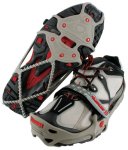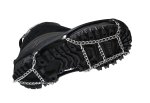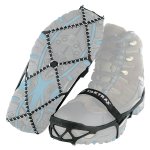Starved Rock State Park is a premiere park in central Illinois that is located just south of I-80.
Starved Rock is an outstanding park with plenty of history, awesome waterfalls, and an excellent Lodge with great food! Once I discovered this place, the wife and I used to make it an annual winter destination until the baby girl put a temporary pause to it. I have yet been able to hike the park when it isn’t frozen, but it is definitely on the short list. When it comes to Midwest winter hikes, this place is amazing! During the early spring the park has around a dozen flowing waterfalls along a 12ish mile river trail. During the winter the main draw is 7 frozen waterfalls. Not only that, but the park also boasts eagle watching, an excellent restaurant, and let’s not forget the fudge!. Let’s get to the hiking…
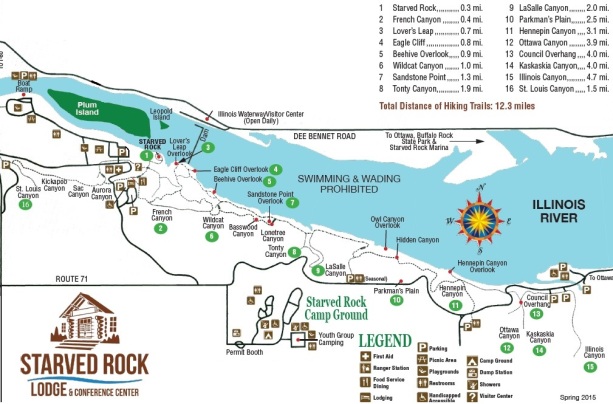
While there is a network of trails connecting everything together, I like to section the park off into 3 areas during the winter. The first is St Louis on the western edge, then the core four falls of French, Wildcat, Tonty, and LaSalle in the center, with the eastern edge being the third section with Kasakakia and Ottawa. Our normal itinerary is to drive over from Iowa, hit the outlier falls, eat at the lodge, overnight in Oglesby, then return for the core four after breakfast, and head home.
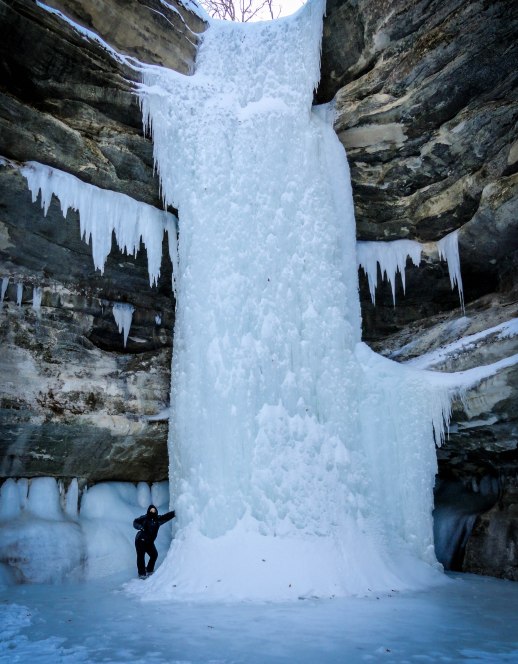 St Louis Canyon is always the first stop for icefall hunting since there is a parking area just off the main road from Utica. The road actually leads all the way down to the trailhead, but it is steep and they close it off in winter. So you have to park at the top of the hill and walk down to the trailhead. Once you are on the trail it follows a creek through the canyon that leads to the fall. It is a tall waterfall that can create an impressive block of ice, as the lovely Cheryl demonstrates. The hike through the canyon is one of the better hikes in the park.
St Louis Canyon is always the first stop for icefall hunting since there is a parking area just off the main road from Utica. The road actually leads all the way down to the trailhead, but it is steep and they close it off in winter. So you have to park at the top of the hill and walk down to the trailhead. Once you are on the trail it follows a creek through the canyon that leads to the fall. It is a tall waterfall that can create an impressive block of ice, as the lovely Cheryl demonstrates. The hike through the canyon is one of the better hikes in the park.
We retraced our path back to the car so we could drive to the far eastern side of the park and check out Ottawa Canyon, Kaskaskia Canyon, and the Council Overhang where reportedly the Illini indians conducted meetings. The trails aren’t very long for this section of the park, so it’s a quick little trip to see the two falls if you’re running low on time and light. Ottawa can grow to be a pretty thick icefall that attracts climbers. In the picture below you can see some red rope at the base of the fall from a pair of climbers up top preparing to climb it.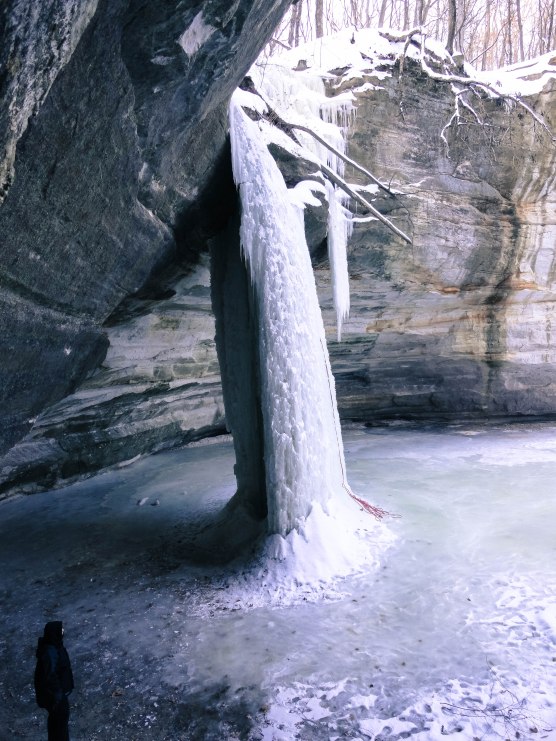
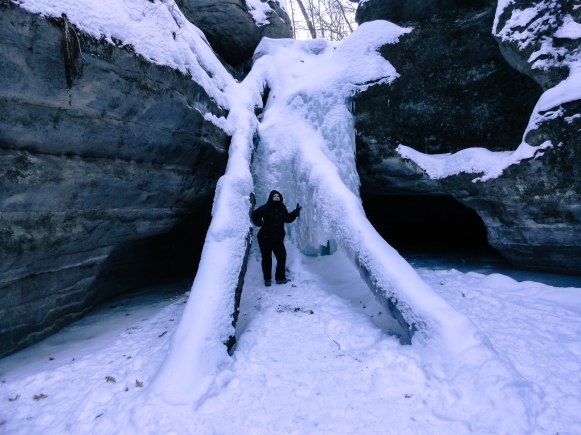
Kaskakia is by far the smallest of the frozen falls. There is a little alcove behind it that you can crawl around, but otherwise, bring a model with you for some posing like I did. 😉 After we competed out first day of hiking we had dinner at the lodge located on the grounds which was excellent!

The next morning we began our primary focus, hitting up the core icefalls.

It was time to get serious… The first stop was French Canyon, a good-sized fall that is super broad. The trailhead is located at the southeast corner of the parking lot for the lodge. The descent can be a little tricky if there is a heavy snowfall and it gets packed down on the stairs. Mostly it makes it hard to get footing, so be aware of that.

Next up was Wildcat Canyon. Wildcat is by far the best icefall in the park. This thing is tall and can get super wide. The first time we were there the temps were warmer and we saw a father and son duo scouting the fall for a future climb. The next time we were there we saw climbers hitting up multiple falls, and you can see one getting ready to start a climb below. Wildcat is around 80 feet tall and really grows to an incredible size. There are three vantage points for the fall, two overlooks, and one from below. You should check it out from both the top and bottom to really get an understanding of just how impressive it is. Pay attention to the stairs on the way down… because you’ll have to climb them on the way out!

Don’t worry about that for now though, you get to hike to a couple other falls before you have to come back. After leaving Wildcat there is river walk for a bit that can at times be a little chilly if the wind is coming off the frozen river. Outside of winter the creek that leads from the Tonty and LaSalle canyons is flowing, meaning you have to take the long way to Tonty since the bridge is out (and has been for years). However, since it is winter when you are looking at icefalls the creek should be frozen. This allows you to take a shortcut and walk on the creek until you can get on the Tonty trail. Tonty Canyon feels like it is in the back corner of the canyon. It can be a bit sporadic in its growth. There are times I’ve seen it full, with climbers, like the photo below, and other times where there isn’t much formed. Its kind of a little guessing game as to what you get to see when you round the corner.

From there the trail leads to LaSalle, which almost never disappoints. I’m not sure why, but it almost always seems to form with a hole in the center. You can kind of make out the remnants of the hole in the photo below. LaSalle is interesting in that as part of the trail you have to walk behind it. So this allows for some nice shots where you can sometimes get the greenish-blue color from the light seeping through.
This completed the tour of icefalls, so we headed on back down what’s probably the best canyon trail in the park, to the namesake.
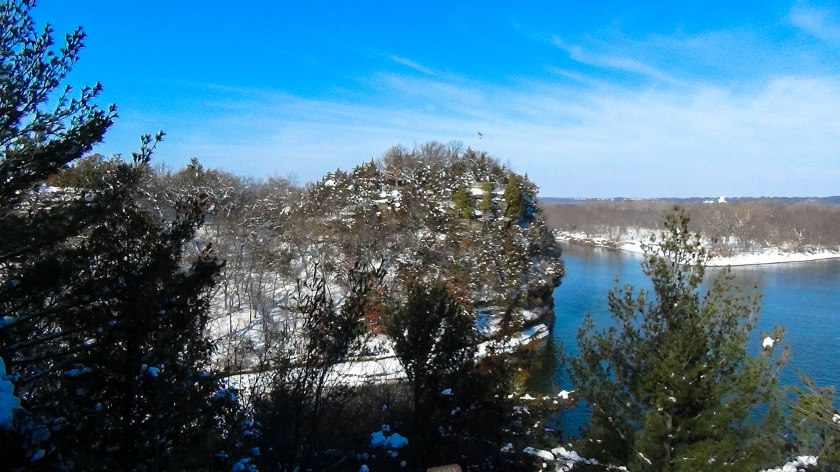
Starved Rock State Park is an excellent winter hike. As far as recommendations for gear and who can hike this; first I would say that as long as you can handle a good amount of stairs and maintain your balance on some uneven terrain, you should be able to see most of the falls since you can drive relatively close to them and park. St. Louis, Tonty and LaSalle Canyons would be more challenging since they all involve a longer walk to get to them. Now if you would like to hike from end to end, I would suggest you know your limits and monitor the temps appropriately.
Make sure you layer well so you can put on more layers during idle periods, and then peel them off as you heat up from hiking to prevent sweating that will freeze when you go idle again. On top of that, resist wearing materials made of cotton as the snow and water will be “attracted” to them, soak in and freeze. Instead try to wear clothing made of polyester and nylon materials. Most outdoor focused companies will generally make their clothing out of non-cotton material already. Waterproof boots are a must. A couple other nice items to bring are leg gaiters and shoe chains.
 Leg gaiters are leggings normally made of nylon that cover the top of your boot and lower leg to help keep the environment out.
Leg gaiters are leggings normally made of nylon that cover the top of your boot and lower leg to help keep the environment out.
Shoe chains/ micro spikes/ Yaktrax and what ever else they are called are basically snow chains for your boots. They vary greatly by brand from simple coils, to chains, to sharp spikes with chains.
I would bring plenty of water and snacks to drink/eat often. It is very easy to dehydrate in the winter as your body will consume a little more with the increased effort of trudging through a snowy path, as well as trying to keep you warm. One recommendation, use a water bottle over a hydration bladder. The hoses on the bladder are more likely to freeze, preventing you from getting a drink. The importance of food is similar in that the extra effort will burn more calories, and the effort of eating and digestion will help to stoke your internal furnace keeping your body temp up. The worse thing you could do is dehydrate without eating and drop your core temp. You’ll have a miserable day of just wanting to get to the car or lodge for a warm bite. Of course as always, bring a map.
If you are looking to stay at the lodge or one of the cabins on site make sure to plan ahead as most of the accommodations are booked well over a year in advance. We always just stay in Oglesby which is a short distance down the road.
One thing about Starved Rock is that they know what they are, a tourist destination. They have many different activities available that change often, such as eagle watching tours, guided hikes, and more. I’d encourage anyone interested in the park to browse the main website and see if there is anything that interests you. I will fully recommend the lodge’s restaurant as we have never been disappointed with the food!
The best time of year for the ice falls is late January and early February, especially after there has been a lot of recent thawing and refreezing. Oh and the temps have been consistently below 20 to make sure everything is solid when you visit.
This is a must visit location that I know I’ll enjoy returning to annually once again. Remember to watch the video on my YouTube channel to help entice you to visit!



